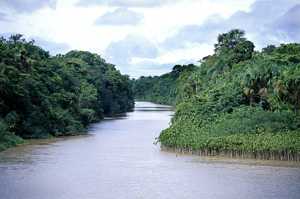Swimming
There are no means yet known that would control naturally occurring Naegleria fowleri levels in lakes and rivers making prevention difficult. Because of this, swimmers and other recreational water users should assume that there is always a low level of risk whenever they enter warm freshwater lakes, rivers, and hot springs (for example, when swimming, diving, or waterskiing), particularly in southern-tier states.
What You Can Do
The only certain way to prevent a Naegleria fowleri infection due to swimming is to refrain from water-related activities in warm freshwater. Personal actions to reduce the risk of Naegleria fowleri infection should focus on limiting the amount of water going up the nose.
These actions could include:
- Hold your nose shut, use nose clips, or keep your head above water when taking part in water-related activities in bodies of warm freshwater.
- Avoid putting your head under the water in hot springs and other untreated thermal waters.
- Avoid water-related activities in warm freshwater during periods of high water temperature.
- Avoid digging in, or stirring up, the sediment while taking part in water-related activities in shallow, warm freshwater areas.
These recommendations make common sense but are not based on any scientific testing since the low numbers of infections make it difficult to ever show that they are effective.
Education
Routine, enhanced education of the public in advance of the summer swim season might be helpful. Education should put Naegleria fowleri infection in the context of other risks associated with recreational water use to help raise awareness and assist swimmers in making informed choices about their recreational activities. Healthcare professional education may be useful in speeding diagnosis and treatment.
Environmental Testing & Posting Signs
In general, CDC does not recommend testing untreated rivers and lakes for Naegleria fowleri because the ameba is naturally occurring and there is no established relationship between detection or concentration of Naegleria fowleri and risk of infection. Environmental testing may be warranted for investigations in which Naegleria fowleri detection may be useful for establishing geographical distribution in new environments 1, survival in disinfected water bodies, or in household water systems 2.
Posting signs based on finding Naegleria fowleri in the water is unlikely to be an effective way to prevent infections. This is because:
- Naegleria fowleri occurrence is common, infections are rare.
- The relationship between finding Naegleria fowleri in the water and the occurrence of infections is unclear
- The location and number of amebae in the water can vary over time within the same lake or river 3-7.
- There are no rapid, standardized testing methods to detect and quantitate Naegleria fowleri in water.
- Posting signs might create a misconception that bodies of water without signs or non-posted areas within a posted water body are Naegleria fowleri-free.


CDC does not recommend testing untreated bodies of water, like lakes and rivers, for Naegleria fowleri.
References
- Ettinger MR, Webb SR, Harris SA, McIninch SP, C Garman G, Brown BL. Distribution of free-living amoebae in James River, Virginia, USA. Parasitol Res. 2003;89:6-15.
- Yoder JS, Straif-Bourgeois S, Roy SL, Moore TA, Visvesvara GS, Ratard RC, Hill V, Wilson JD, Linscott AJ, Crager R, Kozak NA, Sriram R, Narayanan J, Mull B, Kahler AM, Schneeberger C, da Silva AJ, Beach MJ. Deaths from Naegleria fowleri associated with sinus irrigation with tap water: a review of the changing epidemiology of primary amebic meningoencephalitis. Clin Infect Dis. 2012;1-7.
- Maclean RC, Richardson DJ, LePardo R, Marciano-Cabral F. The identification of Naegleria fowleri from water and soil samples by nested PCR. Parasitol Res. 2004;93: 211–17.
- Wellings FM, Amuso PT, Chang SL, Lewis AL. Isolation and identification of pathogenic Naegleria from Florida lakes. Appl Environ Microbiol. 1977;34(6):661–7.
- John DT, Howard MJ. Seasonal distribution of pathogenic free-living amebae in Oklahoma waters. Parasitol Res 1995;81(3):193–201.
- Duma RJ. Study of pathogenic free-living amebas in fresh-water lakes in Virginia. 1980;EPA-PB-126369, Summary, 1981 is EPA-600/S1-80-037.
- Kemble SK, Lynfield R, DeVries AS, Drehner DM, Pomputius WF 3rd, Beach MJ, Visvesvara GS, da Silva AJ, Hill VR, Yoder JS, Xiao L, Smith KE, Danila R. Fatal Naegleria fowleri infection acquired in Minnesota: possible expanded range of a deadly thermophilic organism. Clin Infect Dis. 2012;54:805-9.
- Page last reviewed: February 28, 2017
- Page last updated: February 28, 2017
- Content source:


 ShareCompartir
ShareCompartir